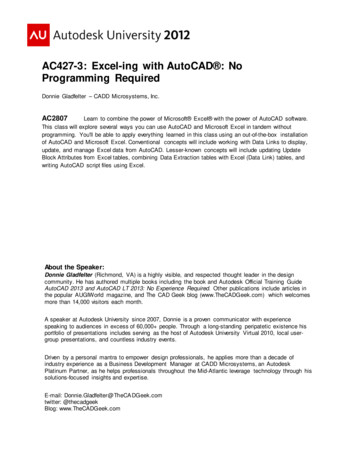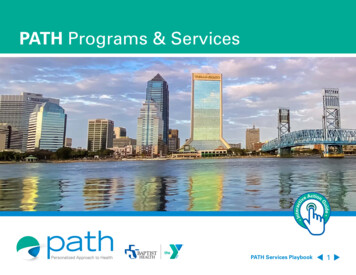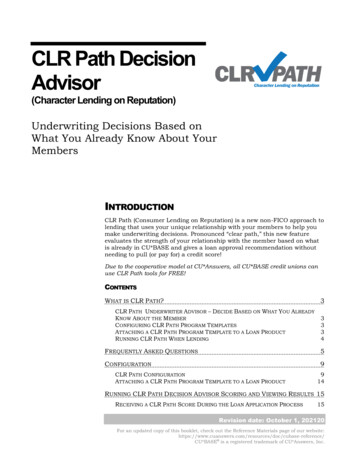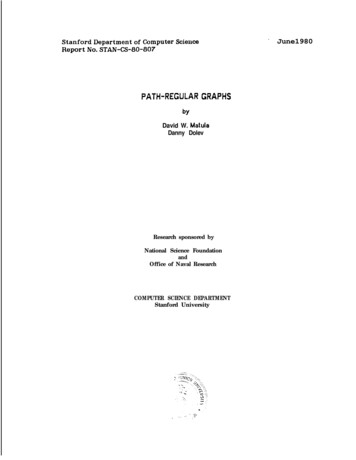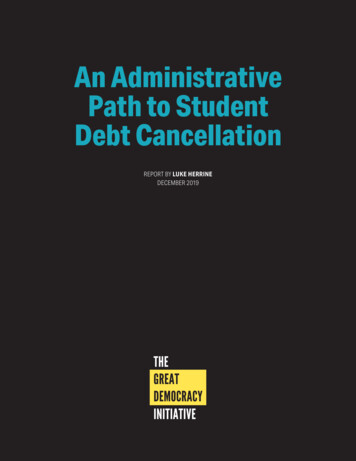
Transcription
An AdministrativePath to StudentDebt CancellationREPORT BY LUKE HERRINEDECEMBER 2019
ABOUT THE AUTHORLuke Herrine is a PhD Candidate in Law at Yale LawSchool. Previously he served as the Legal Director ofthe Debt Collective, where he helped design the legaland organizing strategy that pressured the Departmentof Education to begin to cancel the debts of defraudedfor-profit college students. He has also worked at theABOUT THE GREATDEMOCRACY INITIATIVEFurman Center on Real Estate and Urban Policy, theThe Great Democracy InitiativeThe Honorable Rosemary Pooler on the Second Circuitoffer solutions to the most pressingSchool of Law.develops policy blueprints thatConsumer Financial Protection Bureau, and the Centerfor Human Rights and Global Justice. He clerked forCourt of Appeals. His JD is from New York Universityproblems of our time. From tamingthe concentration of power inour economy to fundamentallyreforming our broken government,GDI aims to generate policy ideasthat confront the forces that haverigged our society in favor of thepowerful and connected.ACKNOWLEDGMENTSThe author thanks Eileen Connor, Aaron Ament, DanZibel, and Julie Margetta Morgan for their thoughtfulcomments. He also thanks Deanne Loonin and RobynSmith for their earlier work on the topic of the powersdiscussed in this report.
Executive SummaryThe 1.6 trillion student debt crisis has led to recent legislative proposals to cancelstudent debt. This report considers the possibility of implementing a student debt jubileewithout further legislation. In particular, it argues that the Department of Education(ED) could run a debt cancellation program without further instruction from Congress,at least for the public student loans over which ED has control (Direct Loans) or couldobtain control through existing legal mechanisms (FFEL and Perkins Loans).Congress has already given ED the discretion to “compromise, waive, or release” itsclaims over student debtors. Further, current law prohibits courts from reviewingadministrative agencies’ discretionary determinations not to enforce laws within theirbailiwick unless Congress provides explicit guidance for how to do so. This reportreviews the likely legal hoops that ED and other instrumentalities in the executivebranch would have to jump through in order to implement a student debt jubileewithout further congressional action and the potential legal and political challenges thatthey would face in doing so. 2019 GREATDEMOCRACYINITIATIVE.ORG3
Introduction“Cancel student debt” has moved from radical slogan to serious policy proposal in thepast five years; it may move from proposal to reality within the next five. An increasingnumber of candidates in the race for the Democratic presidential nomination haveproposed canceling at least some student debt as part of their plans for reforming highereducation.i Two of these proposals have taken concrete form as competing bills withsponsors in both chambers of Congress.ii Meanwhile, this past year has already seena study on the likely macroeconomic and distributional impacts of full student debtcancellation, and two white papers from progressive think tanks analyzing variousalternative approaches to cancellation.iiiProposals to cancel large proportions of student debt poll well, and as they begin tobecome more accepted within the domain of legitimate debate, more politicians arelikely to see benefit in supporting them.iv The most straightforward way to implement anyof these varieties of student debt cancellation would be through legislation. Congress hasplenary power to cancel obligations to the federal government, to authorize spending,and to determine the taxability of canceled debt. Any of the proposals currently on thetable could become reality through statute without serious legal challenge. However,even as a growing number of politicians have begun to support student debt cancellation,majorities in Congress might not appear overnight. This report explores one way aPresident could make a student debt jubilee a reality without waiting for Congress.1All debt cancellation proposals that have been memorialized into draft bills would runthe cancellation through the Department of Education (ED). This report argues thatED could run a debt cancellation program without further instruction from Congress,at least for the public student loans over which ED has control or could obtain controlthrough existing legal mechanisms.2 Congress has already given ED the discretion to“compromise, waive, or release” its claims over student debtors. Further, current lawprohibits courts from reviewing administrative agencies’ discretionary determinationsnot to enforce laws within their bailiwick (i.e., their “enforcement discretion” or12Generally, debt cancellation proposals have been paired with proposals for reducing future student debt loads by makinghigher education more affordable and for reducing the burden of those debt loans by reforming rules pertaining to repayment,collections, and bankruptcy. These proposals are important, but beyond the scope of this report.ED only has authority over public student loans, so this report only pertains to the ability to cancel public student loan debt.Whenever “student debt” is referred to below, it is shorthand for “public student loan debt.” Approximately 95 percent ofstudent loan debt is public, and that share grows every year. As will become clear, the control that ED has over public studentloans varies with the type of loan (Direct Loans are easy, FFELP and Perkins not so much), but ED has no control and—as far asthe author of this report can tell—no lawful means to obtain control over private student debt. 2019 GREATDEMOCRACYINITIATIVE.ORG4
“prosecutorial discretion,” used interchangeably in this report) unless Congress providesexplicit guidance for how to do so. Congress has provided no such guidance withrespect to ED’s enforcement discretion; thus, unless a federal court creates a limit notcurrently in the law, ED would be able to exercise its discretion without court review.The mechanisms of administrative debt cancellation are relatively simple. To implementdebt cancellation, ED would issue an order waiving/releasing the obligations to repayborrowers’ loans, or whatever portion of their loans the President has decided to cancel.It would then send notifications to the borrowers that some or all of their debts had beencanceled. For the approximately 20 percent of public loans held by non-governmentalparties (those issued under the now-defunct Federal Family Education Loan and PerkinsLoan Program), ED would have to take additional steps to induce the holders of thoseloans to transfer them to ED before ED could cancel them.Although ED has most of the responsibility for administrative loan cancellation, it wouldhave to coordinate with other federal agencies. Because of limitations ED imposed on itselfvia regulation, ED would do best to issue this order jointly with the Department of Justice(ED could also repeal these regulations if necessary). Because cancellation of indebtednesssometimes counts as taxable income under current law, ED would do best to issue thisorder only after obtaining confirmation from the Internal Revenue Service that any suchcancellation would not be counted as part of gross income. Because current executivebranch policy—under so-called “Administrative PAYGO”—might arguably require ED to“offset” the foregone revenue from debt cancellation by cutting other expenditures, EDwould do best to issue this order only after the Office of Management and Budget eithereliminates Administrative PAYGO (as it ought to) or clarifies that the policy would not applyto student debt cancellation. Because all of these instrumentalities of the executive branchwould ideally sign off on any large-scale debt cancellation plan executed through ED’sprosecutorial discretion, the White House would do best to centrally coordinate the policy.ED can cancel student debts owed to it on a class-widebasis without court review.The remainder of this report lays out the basic argument that ED can cancel studentdebts owed to it on a class-wide basis without court review and reviews the legal hoopsthat ED and other instrumentalities in the executive branch would have to jump throughin order to implement a student debt jubilee without further congressional action. 2019 GREATDEMOCRACYINITIATIVE.ORG5
The Department of Education’sDiscretion to Cancel DebtWhat the Higher Education Act SaysThe Higher Education Act (HEA) grants ED the authority to “compromise, waive, orrelease” any claims it has against student debtors. This settlement authority3 has existedsince Congress first created student loans. The first student loans were created withthe National Defense Education Act of 1958. The NDEA gave the Commissioner ofEducation (then the head of a division of the Department of Health, Education, andWelfare)4 the “power to agree to modification of agreements or loans made under thistitle and to compromise, waive, or release any right, title, claim or demand, howeverarising or acquired under” the National Defense Education Loan (NDEL) program.vOn their own terms, the powers articulated in the NDEA are about as broad as can be.“Compromise,” “waive,” and “release” all refer to a legal person’s discretion to decidenot to pursue the full extent of her legal rights (or potential legal rights) against anotherparty. Whereas “compromise” indicates situations in which a (potential) litigant settles apotential legal claim subject to an agreement with the person(s) against whom she has aclaim, “waive” and “release” both indicate a unilateral decision to give up a (potential) legalclaim, regardless of the reason why.vi Thus, the Secretary of Education—or her delegate—has the ability to cancel or write down claims against student debtors either unilaterallyor in exchange for something else, apparently for any reason or for no reason.Over time, the NDEL program became part of—and was then replaced by—the PerkinsLoan program. Although no new Perkins Loans have been issued since 2015, theSecretary of Education still has the authority to “enforce, pay, compromise, waive, orrelease any right, title, claim or demand, however arising” with respect to Perkins Loansstill outstanding.vii These loans currently make up only half a percent of outstandingfederal student loan debt.34This report refers to statutory grants of the power to compromise, waive, negotiate, or otherwise settle a claim as “settlementauthority” to differentiate them from “prosecutorial discretion” (or “enforcement discretion”) more broadly, though grants ofsettlement authority are in fact grants of the ability to exercise prosecutorial discretion.The Secretary of Education inherited all the powers of the Commissioner of Education when the Department of Health,Education, and Welfare split into the Department of Education and the Department of Health and Human Services in 1979. SeePub. L. No. 96-88, § 301(a), 93 Stat. 668, 677 (Oct. 18, 1979). 2019 GREATDEMOCRACYINITIATIVE.ORG6
The Higher Education Act of 1965 created the first permanent student loans (NDELwas conceived as a temporary program as a rapid response to the launch of Sputnik)under the Federal Family Education Law Program (FFELP). FFELP was a program thatguaranteed loans issued by private financial institutions so long as they complied withgovernment regulations. In creating this program, the HEA gave ED the authority to“compromise, waive, or release any right, title, claim, lien, or demand, however acquired”under FFELP.viii No new FFELP loans have been issued since 2010, but they still accountfor around 16 percent of outstanding public student loan debt (measured in dollars).5The remaining 83.5 percent of federal student loans were issued under the DirectLoan Program, initially created as a pilot in 1992. The HEA amendments that createdthem do not explicitly mention anything about the Secretary’s powers to compromise,waive, or release its claims to them, and subsequent amendments have not clarifiedthe matter.ix However, those amendments do make Direct Loans subject to “the sameterms, conditions, and benefits as [FFELP Loans].”x ED has previously asserted, withoutchallenge, that this clause includes its authority to compromise, waive, or release claims.xiThese grants of settlement authority contain no guidance for how the authority canor cannot be used. The only explicit limits that Congress has placed on ED’s discretionare nominal. Section 433(a) of the Higher Education Opportunity Act of 2008 reads asfollows: “The Secretary may not enter into any settlement of any claim [under FFEL orPerkins, or by implication, Direct Loans] that exceeds 1,000,000 unless (1) the Secretaryrequests a review of the proposed settlement of such claim by the Attorney General; and(2) the Attorney General responds to such request.”xii The most natural reading of thissection6 is as a limit on ED’s ability to exercise discretion with respect to any individualdebt over 1 million. It seems that there are at least some debtors who owe that muchmoney, but it is not clear how many. Even for their debts, however, this section onlysets a limit on the amount of discretion that ED can exercise by itself.xiii So long as EDconsults with the relevant officials in the Department of Justice, this section sets nolimits on the amount of discretion that can be exercised without consulting Congress.56This number includes all outstanding FFELP loans. Of these, 57 percent are held by private lenders, 11 percent by guarantyagencies, and 32 percent by ED itself.This is argued at greater length in the law review article that this report draws upon. The basic argument is that the repetitionof “any” (“any settlement of any claim”) seems to separate out the individuation of the decision to settle debts from theindividuation of the claims/debts being settled. 2019 GREATDEMOCRACYINITIATIVE.ORG7
The Higher Education Act in the Context of the Law of Prosecutorial DiscretionThe grants of settlement authority in the HEA were enacted during an era in whichadministrative agencies’ authority to exercise discretion to settle federal claimswithout explicit grants of statutory authority was not clearly established. Because theAttorney General’s authority to settle both criminal and civil claims—her “prosecutorialdiscretion”—was understood to be inherent or else implicit in the Judiciary Act of1789,xiv during this era it was standard practice for agencies without explicit grantsof settlement authority to refer all potential compromises and settlements to theDepartment of Justice (DOJ). Apparently agencies with explicit grants, such as thosein the HEA, did not have to take this step. Eventually, the DOJ became weary of havingto approve every niggling settlement and pressed for the passage of the Federal ClaimsCollection Act of 1966 (FCCA). As discussed below, the FCCA (later amended as the DebtCollection Improvement Act) created a blanket grant of authority to settle claims undera certain amount subject to regulations developed jointly by the Department of Treasury(“Treasury”) and DOJ.xv The FCCA was designed to act as a backstop; agencies, like ED,with separate grants of settlement authority may simply rely on those. They neither gainnor lose power under the FCCA.xviHowever, in a 1985 case called Heckler v. Chaney, the Supreme Court made clear thatthere is nothing special about the Attorney General with respect to the discretion todecline to enforce claims of the federal government and that explicit grants of suchdiscretion are not actually required.xvii All federal officials charged with enforcing legalobligations have discretion to decline to enforce those obligations, in whole or inpart, for any reason, unless that discretion is circumscribed by statute.7 The power todecline to enforce—sometimes referred to as “prosecutorial discretion” and sometimes“enforcement discretion”—need not be explicitly granted: It is implicit in the grant of thepower to enforce. Of course, where there is an explicit grant of settlement authority, thelanguage of that grant binds the agency and guides courts in reviewing (or declining toreview) the actions of that agency.7This includes “[p]ower to release or otherwise dispose of the rights and property of the United States,” even though that poweris “lodged in the Congress by [Article IV of] the Constitution.” Royal Indemnity Co. v. U.S., 313 U.S. 289, 294 (1941) (citing U.S.Const. Art. IV, § 3, Cl. 2). That is because Congress can confer that power to an official in the executive branch (and confer thepower to delegate it), including by giving an official the power to dispose of federal property, to enter into contracts, to settleclaims, and the like. See id.; Alcoa, Inc. v. Bonneville Power Admin., 698 F.3d 774, 791-92 (9th Cir. 2012). 2019 GREATDEMOCRACYINITIATIVE.ORG8
As a general matter, prosecutorial discretion is absolute, meaning it can be exercised forany constitutional reason without any form of court review.8 The term “prosecutorialdiscretion” may seem to imply a form of discretion that pertains only to thedetermination as to whether and how to prosecute a case, in the sense of bringing andmanaging a lawsuit. But the language should not mislead. Unless otherwise specified,prosecutorial discretion is the ability to make any decision about whether and how topursue a legal claim (or potential legal right), including whether and when to waivethat claim. Waiver of a claim can occur before it arises.9 In the leading case of Hecklerv. Chaney, the Supreme Court did not even require the federal agency in question—theFood and Drug Administration (FDA)—to investigate a potential violation of the law itwas charged with enforcing.Further, it is well established that enforcement discretion can be used to implementsystematic policies that legislatures have not explicitly approved of and that evenundermine explicit legislative intent. For instance, federal and state prosecutorshave used their discretion to create pretrial diversion programs in which an allegedlawbreaker is given a probationary period that, if completed without violating theprosecutor’s terms, prevents the lawbreaker from being charged.xviii A growing numberof prosecutors have also begun to effectively decriminalize certain actions thatlegislatures have criminalized, such as marijuana possession. Similarly, systematicdiscretion has been exercised in the civil context under the rubric of “deferred action”to indefinitely delay deportation for certain classes of immigrants, making them eligiblefor certain benefits (though, as discussed below, the legitimacy of deferred action iscurrently in limbo). In all of these circumstances, enforcement discretion is used in aquasi-legislative manner to enact prosecutors’ priorities, even if those policies are intension with that of the law they are charged with enforcing.It is always Congress that grants the authority to decline to enforce, even if implicitly,by granting the authority to enforce. As such, Congress can always take away or89This is true for all forms of prosecutorial discretion as a matter of common law read in the shadow of the Constitutionalseparation of powers. As it pertains to administrative agencies, 701(a)(2) of the Administrative Procedure Act (APA) enacts intostatutory law the common law principle that “administrative actions committed to agency discretion by law” are unreviewableby courts. See Heckler, 470 U.S. at 836; Webster, 486 U.S. at 607-10 (Scalia, J., dissenting). For other applications of Section701(a)(2), see, e.g., Weyerhaeuser Co. v. U.S. Fish & Wildlife Serv., 139 S. Ct. 361, 370 (2018); Lincoln v. Vigil, 508 U.S. 182, 191(1993); Franklin v. Massachusetts, 505 U.S. 788, 817 (1992); Webster, 486 U.S. at 599-600; ICC v. Locomotive Engineers, 482U.S. 270, 282, (1987).In fact, this is the form in which “a waiver” is most familiar to non-lawyers. If you sign a document stating that you understandthe risks of, say, a dangerous theme park ride, you are promising not to sue if you are harmed in a way that could give rise to alegal claim. 2019 GREATDEMOCRACYINITIATIVE.ORG9
circumscribe an agency’s discretion in how an enforcement power is used. Becausecommon law, constitutional law, and good sense all provide reason for a court to avoidpolicing executive branch officials’ discretion subject to its own standards, Congressmust be explicit about whatever limits it sets. In the jargon of this area of doctrine, itmust create “law to apply” in reviewing an official action, and not leave it to judges tocome up with principles for how discretion ought to be exercised.xixThe HEA grants ED the authority to enforce claims against debtors, at least once EDcomes into possession of their loans.10xx As discussed in the preceding section, the HEAalso grants ED the power to “compromise, waive, or release” and only explicitly limitsthis authority by compelling ED to consult with the Attorney General in writing downindividual debts of more than 1 million, which is of no practical importance in a worldwhere nobody has that much student debt. At least as an initial matter, then, it wouldseem that the HEA gives ED absolute and unreviewable discretion to cancel or writedown its claims against student debtors.The HEA gives ED absolute and unreviewablediscretion to cancel or write down its claims againststudent debtors.ED’s Regulations Limiting Its Settlement Authority and How to Avoid Those LimitsAlthough the HEA creates no explicit limits, ED has limited its own discretion viaregulations passed in 2016. In relevant part, those regulations only allow ED to“compromise suspend, or terminate collection of a [FFELP, Direct, or Perkins Loan] debtin any amount” so long as it does so “under the provisions of 31 CFR part 902 or 903.”xxi The“provisions of 31 CFR part 902 or 903” are parts of the Federal Claims Collections Standards(FCCS). The FCCS were developed jointly by DOJ and Treasury to guide agencies thatget their settlement authority from the FCCA. As mentioned above, because ED gets itssettlement power from a statute other than the FCCA, it is under no obligation to followthe FCCS. Thus, imposing the FCCS on itself creates constraints that the HEA does not.We need not review the details of those constraints here. That is because they do notlimit ED so long as it consults with the Attorney General (or his delegate in DOJ), and10It does so in the same provisions that it grants the authority to “compromise, waive, or release” such claims. 2019 GREATDEMOCRACYINITIATIVE.ORG10
presumably having a President that makes student debt cancellation a priority wouldensure that that consultation would go smoothly.11Alternatively, ED could always repeal its current regulations and replace them withregulations that simply enact the full breadth of prosecutorial discretion provided by theHEA. Doing so would require going through a time-consuming rulemaking proceeding(that would likely take over a year),12 but it is perfectly permissible. Indeed, doing sowould merely be to revert the regulations back to the form they took before 2016.xxiiWrinkles Pertaining to FFELP and Perkins LoansThe nature of ED’s authority to enforce the obligation to pay student debts (and thereforeto waive this obligation) depends on the type of student loan at issue. Three types ofpublic student loans are relevant for present purposes: Direct Loans, FFELP (FederalFamily Education Loan Program) Loans, and Perkins Loans. Direct Loans are oweddirectly to ED, but FFELP and Perkins are not. ED would have to act creatively to obtainthe authority to enforce, and therefore to decline to enforce, FFELP and Perkins Loans.ED issues Direct Loans directly, and the debtor’s obligation to repay those loans runsdirectly to ED. Like any other agency with the power to enforce debts to the federalgovernment, ED must “try to collect” these loans.13xxiii So ED has the power to enforce them.14Both FFELP and Perkins Loans are at least initially directly owed to entities other thanED. FFELP Loans are issued by and initially owed to financial institutions on terms thatCongress (via legislation) and ED (via regulation) dictate. ED licenses guaranty agenciesto guarantee all FFELP Loans. It insures these guarantees subject to contracts with theguaranty agencies that are standardized by a combination of legislation and regulation.To minimize the amount of insurance it needs to pay out, ED is charged with ensuringthat guaranty agencies ensure that loans are collected on as much as possible withoutviolating borrowers’ rights. ED can take possession of a FFELP Loan once the guaranty11121314This argument is made in more detail in an accompanying law review article. See Luke Herrine, The Law and Political Economyof a Student Debt Jubilee, 68 BUFF. L. REV. (forthcoming 2020). The basic idea is this: Both text and history pellucidly speak tothe fact the FCCA was enacted and the FCCS were drafted to enable agencies to enter into relatively small settlements withouthaving to consult DOJ, and not to constrain the DOJ’s discretion if and when consulted. Thus, if ED were to consult with DOJ(assuming DOJ were on board with ED’s plan), the specifics of the FCCS would continue to be irrelevant.It is possible ED could establish “good cause” to avoid going through a new rulemaking. See 5 U.S.C. § 553(b)(B).Unlike the HEA, this provision of the Debt Collection Improvement Act (DCIA) seems to require ED to try to collect debts owedto it. The difference is discussed further below.One exception is defaulted loans that have been transferred to the Treasury for tax or benefit offsets. The details of how tocancel those loans, which are covered by the DCIA, go beyond the scope of this report. 2019 GREATDEMOCRACYINITIATIVE.ORG11
agency has paid out the guarantee to the holder (usually the lender) and ED has paid outthe insurance to the guaranty agency. Usually the former assignment (when a loan issold from one creditor to another, it is “assigned”) takes place when a debtor has been indefault for many months despite the repeated efforts of the holder to extract payment,and the latter takes place when the guaranty agency cannot extract payment either.However, ED also takes possession through such double assignment when a debtor iseligible for a statutory discharge—for instance, if a debtor has died or become totally andpermanently disabled. In either case, once ED takes possession, a debtor’s obligation torepay a FFELP Loan runs directly to ED.Because FFELP Loans not in ED’s possession (approximately 68 percent of them) arenot owed directly to ED, ED does not have the power to enforce the obligation to repaythem.15 Presumably, ED would have to take possession of FFELP Loans before it couldexercise the discretion not to enforce the obligation to repay them. Doing so would notbe entirely straightforward. As discussed, ED is explicitly authorized to do so when debtsare in default and the guaranty agency is ready to give up on collecting them as well aswhen a debtor is eligible for one of a few statutory discharges. This authority relates toa small percentage of loans. (But nota bene: If many debtors began to refuse to pay inanticipation of cancellation, it would relate to a growing number.) ED also has the abilityto “compromise[] any claim on, or arising because of” its insurance on the guarantyon FFELP loans.xxiv Using this authority, it might announce its plan to exercise itsdiscretion to cancel or write down some or all FFELP loans that ultimately come withinits possession and then negotiate with guaranty agencies to pay out a lump sum inexchange for assignment of the relevant debts. Debtors would have a lessened incentiveto pay these debts, giving holders/lenders an incentive to sell.16Perkins loans are issued by and initially owed to the college that the student debtoruses the loan to pay. ED provided funds to colleges participating in the Perkins Loanprogram and, subject to the rules created by statute, set the regulations relevant toits management. Unlike with FFELP Loans, ED does not guarantee or insure Perkins1516Approximately 40.1 million of FFELP Loans are in ED’s possession already (mostly because of chronic default), leavingapproximately 237 million in the hands of financial institutions or guaranty agencies.ED has previously gone beyond explicit grants of statutory power to incentivize a guaranty agency to assign a loan to it forcancellation. As far back as 1973, ED informed guaranty agencies that it would not pay out insurance on loans taken outto attend for-profit colleges where there was (more likely than not) consumer fraud. In such situations, the Department candetermine in advance that no holder of the loan should continue to enforce it because it is not legally owed and then accepttransfers from a guaranty agency. See Comment of Margaret Reiter on Notice of Proposed Rulemaking Docket ID ED-2015OPE-0103, 7-10 (Aug. 1, 2016) (reviewing history of non-payment on non-enforceable notes, going back at least to 1973). 2019 GREATDEMOCRACYINITIATIVE.ORG12
Loans. However, ED can take possession of Perkins Loans where such loans have “beenin default despite due diligence on the part of the institution in attempting collectionthereon” or where “an institution of higher education determines not to service andcollect” its Perkins Loans.xxv Once ED takes possession of a Perkins Loan via assignmentfrom a college, it must “attempt to collect” on it “until all appropriate collection efforts, asdetermined by the Secretary, have been expended.”xxviAs with FFELP, it would seem that ED would have to take possession of Perkins Loansbefore being able to enforce them, or, as relevant here, to exercise discretion not to.The best way to do so seems to be for ED t
The 1.6 trillion student debt crisis has led to recent legislative proposals to cancel student debt. This report considers the possibility of implementing a student debt jubilee without further legislation. In particular, it argues that the Department of Education (ED) could run a debt cancellation program without further instruction from .
